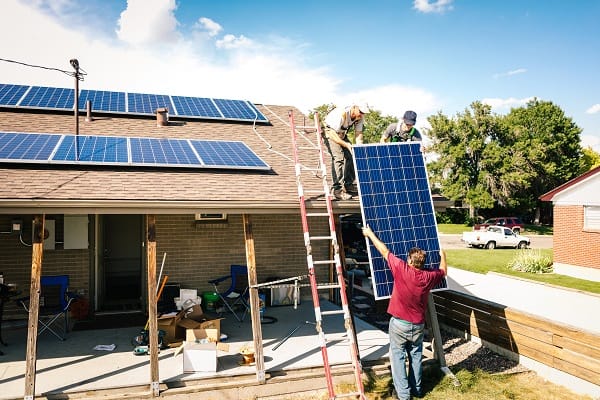Home improvement projects are a great way to give your home a fresh look and an all-around boost, but they’re also an opportunity to make some big green changes. The last couple of years have really hammered home the fact that the climate crisis is here, and everyone needs to get with the programme now. It also helps that going greener can also bring your energy consumption down, which is great news for anyone worrying about bills this winter.
By incorporating eco-friendly practices into your home improvement plans, you can reduce your carbon footprint and create a healthier environment for yourself and future generations. Given how chaotic the property market has been, it’s also a smart time to think about working on your property. Let’s delve into these aspects and discover how they can positively impact your home and the planet.
Energy-efficient solutions
Reducing energy consumption is crucial for creating an eco-friendly home. By implementing energy-efficient solutions, you can decrease your carbon footprint and save money on utility bills. Proper insulation reduces heat transfer, helping maintain comfortable indoor temperatures and minimising excessive heating or cooling. Improve your home’s insulation by adding insulation materials like recycled cellulose, wool, or spray foam insulation to walls, floors, and roofs.
Look for energy efficiency ratings when you’re buying new appliances. A+++-rated machines meet strict energy efficiency guidelines, consuming less electricity and reducing greenhouse gas emissions. Energy-efficient refrigerators, washing machines, dishwashers, and HVAC systems are excellent choices for eco-friendly home improvement.
Replace traditional incandescent light bulbs with energy-efficient LED bulbs. LED lights consume significantly less energy, have a longer lifespan, and emit less heat. Incorporate natural lighting into your home design to reduce the need for artificial daylight during daylight hours. Install smart home devices such as programmable thermostats, occupancy sensors, and smart power strips. These devices allow you to automate and control energy usage, optimising efficiency and reducing wastage.
Use greener materials
You can make a big dent in your carbon footprint by looking for greener materials for your projects. Traditional building materials often contribute to deforestation, pollution, and increased energy consumption. By opting for sustainable alternatives, you can minimise these negative effects. When incorporating wood into your home improvement projects, choose sustainably sourced timber certified by organisations such as the Forest Stewardship Council (FSC). FSC-certified wood ensures responsible forestry practices, minimising environmental damage.
Incorporate recycled materials into your projects whenever possible. Products made from recycled plastic, glass, metal, or reclaimed wood can reduce waste and conserve resources. For instance, recycled glass countertops or tiles can add a unique touch to your kitchen or bathroom while minimising the environmental impact. Bamboo is a rapidly renewable resource that can be an excellent alternative to traditional hardwood. It grows quickly and regenerates without the need for replanting. Bamboo flooring, furniture, and cabinets are durable and aesthetically pleasing options for an eco-friendly home improvement. Traditional paints release volatile organic compounds (VOCs) that contribute to indoor air pollution and harm human health. Look for low-VOC or VOC-free paints with lower levels of toxic emissions. These paints are safer for you, your family, and the environment. You should also look for materials that don’t have formaldehyde, especially if you’re looking for cabinets and display cases. Medite MDF is a great example of eco-friendly material, and you can get MDF cut to size at Cworkshop. They use Cutting Optimisation software, meaning there’s no material waste when creating your order. Less waste is ideal for anyone putting a big project together, both in terms of budget and the planet!
Water conservation
You’ll have seen the stories about drought and hosepipe bans already this year, but water conservation will only be more important in the future. You can reduce water consumption and promote water efficiency by implementing water-saving measures in your home improvement projects. Install low-flow showerheads, faucets, and toilets to reduce water usage. These fixtures use less water while providing a satisfying user experience. Incorporate rainwater harvesting systems into your home improvement plans. Collecting rainwater from your roof and storing it in tanks allows you to use it for non-potable purposes like watering plants, cleaning, or flushing toilets. It reduces the demand for treated water and promotes self-sufficiency.
Consider xeriscaping your outdoor areas by choosing native plants that require less water. Native plants are adapted to local climate conditions, reducing the need for excessive watering. Mulching the soil and using efficient irrigation systems, such as drip irrigation, can further conserve water. Implement greywater recycling systems to reuse water from sinks, showers, and washing machines for irrigation purposes. Greywater systems filter and treat the water, making it suitable for non-potable uses.
Sustainable landscaping
Enhancing your outdoor spaces with sustainable landscaping practices can significantly contribute to an eco-friendly home improvement. Choose native plants for your garden, as they are better adapted to local conditions and require less water, fertiliser, and maintenance. Think about what plants are going to do well with the increase in temperatures. Native plants also provide habitat and food for local wildlife, promoting biodiversity. Use permeable materials like permeable pavers or gravel instead of traditional concrete or asphalt for walkways and driveways. Permeable surfaces allow rainwater to infiltrate the ground, reducing stormwater runoff and replenishing groundwater.
Implement a composting system to convert kitchen scraps, yard waste, and leaves into nutrient-rich compost. Composting reduces waste sent to landfills and provides a natural fertiliser for your garden. Install efficient irrigation systems such as drip irrigation or weather-based controllers to ensure targeted watering and minimise water waste.
Conclusion
Embracing eco-friendly practices in your home improvement projects benefits the environment, enhances your living space, and saves money in the long run. By using greener materials, incorporating energy-efficient solutions, conserving water, and implementing sustainable landscaping, you can positively impact the planet while creating a healthier and more sustainable home. Whether renovating, remodelling, or building from scratch, going eco-friendly is a responsible choice that will benefit you and future generations. By incorporating these ideas into your home improvement plans, make a difference today.






Leave a Comment